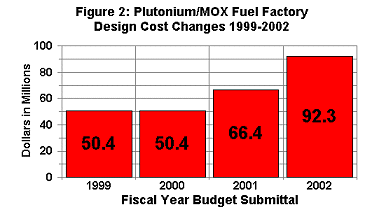|
Plutonium
Fuel Factory
Why Have Costs Doubled?
The Department of Energy (DOE) cites the
addition of "aqueous polishing"; more
accurately termed liquid acid plutonium
processing. DOE originally claimed that low-waste
producing, "dry" plutonium processing
would be used and refused to analyze liquid acid
processing as a "reasonable
alternative" until 1999. Oak Ridge National
Laboratory reported in December, 2000 that:
"A Decision was made in 1997 that the
plutonium oxide would be polished to remove
impurities and to control the powder
characteristics." DOE withheld this
information from Congress and the public.
Why Has Size More Than
Doubled?
The change from dry to liquid
acid plutonium processing accounts for part of
the size change. Other factors more recently
reported include:
full automation (meaning
fewer jobs)
an increased storage area
(meaning higher risks from an accident);
"enhanced seismic,
life safety, and physical security
features to meet U.S. requirements,"
(meaning that the original proposal from
Duke Cogema Stone and Webster did not
adequately account for U.S. laws and
regulations).
Design
Cost Increases for the Plutonium Fuel Factory
1999 - 2002
Project: Mixed Oxide Fuel
Fabrication Facility - Title I & II Design
2a. Project No. 99 - D - 1431
Fiscal Year |
Design Cost Estimate,
Title I & II Design |
Hardened Space |
Size
Estimate
(in
Square Feet)
Support Space |
Total Space |
1999
|
$50,375,000
(50.4 Million Dollars). First Year
Funding
|
100,000 |
100,000 |
200,000 |
| 2000 |
$50,375,000
(50.4 Million Dollars)
|
120,000 |
55,000 |
175,000 |
| 2001 |
$65,375,000
(60.4 Million Dollars). Reason for
Increase: "The addition of anaqueous
processing step prior to fabricating
mixed-oxide fuel."
|
160,000 |
55,000 |
215,000 |
| 2002 |
|
320,000 |
120,000 |
440,000 |
| |
$92,318,000 (92.3 Million
Dollars). Reason for Increase: "The
recharacterization of a portion of
project operating costs as Total
Estimated Cost (TEC) components,
adjustment of DOE contingency, cost
growth related to physical security
design requirements, and schedule slips
resulting from late issuance of the
January 1997 Surplus Plutonium
Disposition Record of Decision
(ROD)." |
Reasons for
doubling of size: "full automation,
an increased storage area, and a
laboratory...enhanced seismic, life
safety, and physical security features
are included in the current sign to meet
U.S. requirements." |
1
Sources: Department of Energy
Budget Request Justifications, Fiscal Years 1999
to 2002.
Aug. 23, 2001: PLUTONIUM FUEL FUNDING NEARLY
EXHAUSTED , BAD COST ESTIMATES PLAGUE PROGRAM -
Documents obtained this week by the Blue Ridge
Environmental Defense League (BREDL) indicate
that funding for the Department of Energy’s
(DOE) Plutonium/MOX fuel program contract is
nearly exhausted. BREDL
Press Release
|
